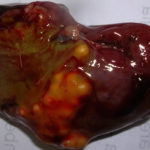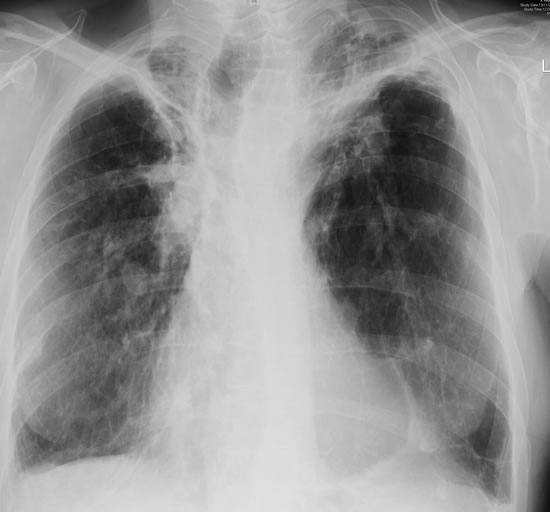Date: 26 November 2013
Born 75 years ago, Pt HK had 3 episodes of tuberculosis as a child and teenager, being treated with PAS and streptomycin. He suffered a ‘bad chest’ all his life and retired aged 54. Presenting with worsening and more frequent chest infections, he was referred with ‘bronchiectasis and Aspergillus sensitisation’. A diagnosis of chronic pulmonary aspergillosis was made in June 2009 on the basis of his chest radiograph and strongly positive Aspergillus precipitins (IgG antibodies) (titre 1/16). He also had Pseudomonas aeruginosa colonisation. His oxygen saturation was 87% and his pO2 6.8, pCO2 6.2 KPa.
His chest radiograph (see above, November 2009) was reported as showing; “ The lung fields are over-inflated. Bilateral apical fibrotic change secondary to old TB. No cavity seen.” At clinic, bilateral apical cavities were seen, with some associated pleural thickening at the left apex, without any evidence of a fungal ball.
He started posaconazole 400mg twice daily with therapeutic levels at subsequent visits. Sputum cultures never grew Aspergillus. Over the following 9 months he had no chest infections requiring antibiotics, his breathlessness worsened gradually and he remained easily fatigued. His Aspergillus antibody titres fell. Overall he felt better, but was concerned about declining respiratory status.
Copyright:
Fungal Research Trust
Notes: n/a
Images library
-
Title
Legend
-
Nasal, sinus and orbital aspergillosis in a cat. Nose- severe bone erosion rostrally through the nasal bone.
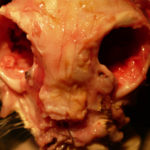
-
Aspergillosis in penguins. Lesions found in captive Magellanic penguins (Spheniscus magellanicus) with aspergillosis as determined by histology.Hyaline, septate and branching hyphae, and asexual reproductive structure of Aspergillus observed in the tissues of Magellanic penguin with fatal aspergillosis. (PAS stain )
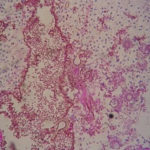
-
Aspergillosis in penguins. Lesions found in captive Magellanic penguins (Spheniscus magellanicus) with aspergillosis as determined by histology. Hyaline, septate and branching hyphae, and asexual reproductive structure of Aspergillus observed in the tissues of Magellanic penguin with fatal aspergillosis. (Grocott’s stain)
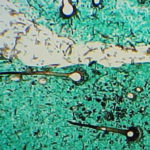
-
Aspergillosis in penguins. Multiple granulomatous nodules at syrinx with necrotic debris and caseous exudates. These lesions were responsible for partial obstruction of the air passages.
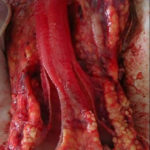
-
Aspergillosis in penguins. Lesions found in captive Magellanic penguins (Spheniscus magellanicus) with aspergillosis as determined by histology. Larges masses formed by multiple nodules in the air sacs and in the adrenal gland.

-
Aspergillosis in penguins. Lesions found in captive Magellanic penguins (Spheniscus magellanicus) with aspergillosis as determined by histology.Adrenal gland involvement (adjacent to kidney) – characterized by massive enlargement to 8-10 cm, formed by multiple granulomatous nodules.

-
Aspergillosis in penguins Lesions found in captive Magellanic penguins (Spheniscus magellanicus) with aspergillosis as determined by histology.Adrenal gland involvement (adjacent to kidney) – characterized by massive enlargement to 8-10 cm, formed by multiple granulomatous nodules.
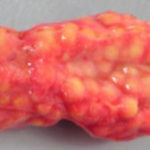
-
Aspergillosis in penguins. Lesions found in captive Magellanic penguins (Spheniscus magellanicus) with aspergillosis as determined by histology.Adrenal gland involvement (adjacent to kidney) – characterized by massive enlargement to 8-10 cm, formed by multiple granulomatous nodules.
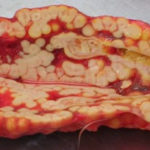
-
Aspergillosis in penguins. Multiple granulomatous nodules in the surface of the kidney

-
Aspergillosis in penguins. Lesions found in fatal cases of captive Magellanic penguins (Spheniscus magellanicus) with aspergillosis. Multiple granulomatous nodules in the parenchyma, characterized by friable necrotic lesions with distorted anatomy of the organ.
